Phytophthora Crown and Root Rot Symptoms and Detection
by Steve Tjosvold, Laura Sims and Matteo Garbelotto
What do you look for when scouting nursery plants for Phytophthora root rot? How do you know your nursery plants have Phytophthora disease? In the accompanying newsletter article “Phytophthora in Restoration and Native Plant Nurseries,” Laura Sims and Matteo Garbelotto describe what Phytophthora is and how to manage it in nurseries. But, here is a description of symptoms and pictorial guide to help you home in on plants that may have Phytophthora root diseases in your nursery.
The expression and severity of Phytophthora crown and root rot depend on the particular plant host, Phytophthora species and environmental conditions. Some plant species limit infection and colonization of their root system resulting in the loss of just a small number of feeder roots. Limited colonization may only cause mild or even no apparent aboveground symptoms. There may be some limited plant stunting or leaf chlorosis evident when compared to healthy plants. However, there is not always a straight-line relationship between the aboveground symptoms (see fig. 1,4,6,8 for examples) and belowground infections (see fig. 2,3,5,7,9). Sometimes infected plants may display limited aboveground symptoms and actually the roots are quite infected. If unmanaged, these plants can act as cryptic sources of the pathogen and its infectious spores can spread to other plants. Usually, however, when root rots are more moderate or severe, aboveground symptoms can include obvious stunting and shoot dieback. Leaves can be smaller than normal and have chlorosis or interveinal chlorosis. Wilting can occur even with adequate soil moisture. When Phytophthora infects at or develops into the root crown near the soil line, the disease is described as a “crown rot.” Often at this stage, leaves may droop, and the plant dies. Cutting just under the bark at or just above the soil line may reveal dead inner bark tissue. The dead tissue may be reddish brown, brown, or black and will differ from healthy tissue, which can be white, green, or pink depending on the type of plant or tissue. Of course, knowing what a healthy plant of the particular species of concern should look like will help in the diagnosis.
Fig. 1. Below Left: Frangula californica (California coffeeberry) with varying degrees of Phytophthora root rot (infected with Phytophthora multivora). Photo: S. Tjosvold.
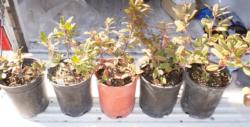
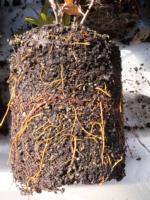
Fig. 2. Upper Right: Frangula californica (California coffeeberry) root systems are uniquely yellow to orange when healthy. Photo: S. Tjosvold.
Root balls must be examined by carefully removing the pot to expose the roots. Sometimes gently shaking, or washing the soil mix from the outer portion of the root ball, can allow for a better examination. Diseased roots can be reddish brown to dark brown while healthy roots are often white to tan, depending on the plant species. So, just as it is important to know what the aboveground parts of healthy plants look like so that you can compare with unhealthy plants, it is also important to know what healthy roots look like in your species for comparison. Do not get fooled by healthy-looking roots of weeds that might infiltrate the root ball. Feeder roots can be rotted away, and heavier roots can be discolored. Fleshy roots of some plant species can be brown, water-soaked and flaccid. They may also be brittle, thin and rotted inside, while healthy roots are often turgid and crisp.
All or some of these described symptoms might be caused by other root pathogens such as Pythium, Rhizoctonia, Thielaviopsis, Fusarium or Cylindrocladium. Abiotic problems such as flooding, drought, extremes of heat or cold, excess fertilizers, or toxic level of salts in irrigation water might also cause these symptoms.
Identifying Phytophthora quickly in the field can be important to make timely management decisions. Agdia (Elkhart, IN) supply simple immunological test kits that detect Phytophthora species in minutes (fig. 10). A positive detection can usually help with the diagnostic process and get you quickly on the path to managing the problem. Sometimes, however, a positive result might be deceiving because these tests are not entirely accurate. Sometimes they can react to certain Pythium or Phytopythium species. These latter two groups of species may or may not be the primary cause of root disease or even a problem at all. Some of these are soil microbes that only break down already dead material, and many we do not fully understand yet. A non-positive reaction of the immunological test might be deceiving also. Sometimes the tested root tissue may not have been sampled from infected root pieces, and certain Phytophthora species do not react with the tests. The reason why these problems can arise is that the tests were developed for particular Phytophthora species that occur on leaves. It just so happens to work pretty darn good on roots as well, but not wholly without issues. For these reasons, to gain identification for critical management decisions, it would be advisable to take disease samples to a professional plant pathology lab where cultures can be obtained and identified.
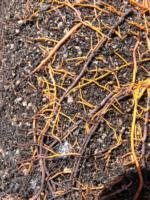
Fig. 3. Frangula californica (California coffeeberry) with necrotic roots infected with Phytophthora multivora. Photo: S. Tjosvold.
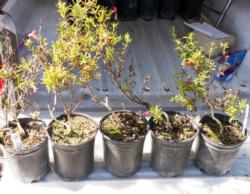
Fig. 4. Diplacus aurantiacus ‘Trish’ with various degrees of Phytophthora root rot (infected with Phytophthora cryptogea). Photo: S. Tjosvold.
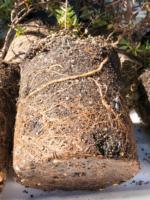
Fig. 5. Diplacus aurantiacus (Sticky monkeyflower) with Phytophthora root rot (infected with Phytophthora cryptogea). All fine feeder roots are infected and necrotic. Phytophthora has not killed larger roots yet. Photo: S. Tjosvold.
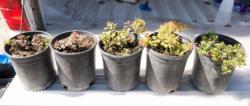
Fig. 6. Arctostaphylos uva-ursi with various degrees of aboveground symptoms; all have Phytophthora root rot (infected with several Phytophthora species). Photo S. Tjosvold.
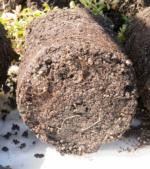
Fig. 7. Arctostaphylos uva-ursi with Phytophthora root rot on feeder roots primarily in the lower soil profile. Photo: S. Tjosvold.
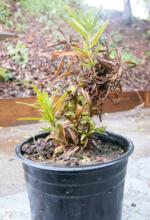
Fig. 8. Diplacus aurantiacus (Sticky monkeyflower) with Pythium root rot (infected with Pythium cryptoirregulare). Photo: S. Tjosvold.
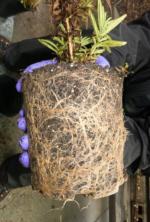
Fig. 9. Diplacus aurantiacus (Sticky monkeyflower) with Pythium root disease symptoms (infected with Pythium cryptoirregulare). Note the many light-brown water-soaked root regions and that this plant is also root bound. Poor root and overly wet conditions may have contributed to the unhealthy nature of this particular plant. Photo S. Tjosvold.
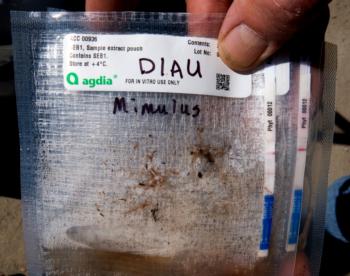
Fig. 10. Immunostrip test for Phytophthora. Symptomatic roots are sampled, macerated in a buffer test solution and pouch. The test strips inserted in the pouch, indicate results in as little as few minutes. Test strips have a magenta-pink-colored “control line” indicating a valid test, as seen in both test strips here. If Phytophthora is detected, then two lines appear: a control line and a “Phytophthora-discovered” line. You can see the latter line next to the red arrow on the strip to the left (although more weakly) but not on the strip to the right. (Photo: S. Tjosvold.
___________________________________________________________
S.Tjosvold is Environmental Horticulture Advisor Farm Advisor, UC Cooperative Extension, Santa Cruz and Monterey counties; L. Sims is Postdoctoral Researcher in the Department of Environmental Science, Policy and Management, UC Berkeley; M. Garbelotto is Extension Specialist in Forest Pathology and Adjunct Professor in the Department of Environmental Science, Policy and Management Department, UC Berkeley.












